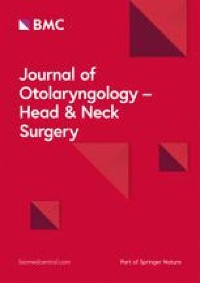|
ΩτοΡινοΛαρυγγολόγος Medicine by Alexandros G. Sfakianakis,Anapafseos 5 Agios Nikolaos 72100 Crete Greece,00302841026182,00306932607174,
Translate
Ετικέτες
Κυριακή 28 Φεβρουαρίου 2021
The Automatic Detection of Heart Failure Using Speech Signals
Workhorse Free Functional Muscle Transfer Techniques for Smile Reanimation in Children with Congenital Facial Palsy: Case Report and Systematic Review of the Literature
|
Perceived utility of electronic noses in patients with loss of smell
|
Thyroid chondroplastic flap for resection of laryngoceles
|
Robotic Posterior Capsule Polishing by Optical Coherence Tomography Image Guidance
|
Relationship of triceps aponeurosis with radial nerve in anterior compartment of the arm
|
Impact of subspecialty training on management of laryngopharyngeal reflux: results of a worldwide survey
|
Comparison of miRNA expressions among benign, premalignant and malignant lesions of the larynx: could they be transformation biomarkers?
|
Identification of E2F transcription factor 7 as a novel potential biomarker for oral squamous cell carcinoma
|
Preparation and validation of cyclodextrin-based excipients for radioiodinated hypericin applied in a targeted cancer radiotherapy
|
Remote medulla ablongata ventral acute subarachnoid hemorrhage following cervical spinal surgery: A case report
|
Early transcriptional changes after UVB treatment in atopic dermatitis include inverse regulation of IL‐36γ and IL‐37
|
Αρχειοθήκη ιστολογίου
-
►
2023
(278)
- ► Φεβρουαρίου (139)
- ► Ιανουαρίου (139)
-
►
2022
(1962)
- ► Δεκεμβρίου (107)
- ► Σεπτεμβρίου (158)
- ► Φεβρουαρίου (165)
- ► Ιανουαρίου (163)
-
▼
2021
(3614)
- ► Δεκεμβρίου (152)
- ► Σεπτεμβρίου (271)
-
▼
Φεβρουαρίου
(64)
- The Automatic Detection of Heart Failure Using Spe...
- Workhorse Free Functional Muscle Transfer Techniqu...
- Perceived utility of electronic noses in patients ...
- Thyroid chondroplastic flap for resection of laryn...
- Robotic Posterior Capsule Polishing by Optical Coh...
- Relationship of triceps aponeurosis with radial ne...
- Impact of subspecialty training on management of l...
- Comparison of miRNA expressions among benign, prem...
- Identification of E2F transcription factor 7 as a ...
- Preparation and validation of cyclodextrin-based e...
- Remote medulla ablongata ventral acute subarachnoi...
- Early transcriptional changes after UVB treatment ...
- Laryngeal and Tracheal Pressure Injuries in Patien...
- Prematurity: A Prognostic Factor for Increased Sev...
- Periodic Fever, Aphthous Stomatitis, Pharyngitis, ...
- Expression of Claudin-1 in laryngeal squamous cell...
- Pilot Study of External Beam Radiotherapy for Recu...
- Gray-Scale Inversion on High Resolution Computed T...
- Current Status of Handheld Otoscopy Training: A Sy...
- Induction of IL‐1β and antimicrobial peptides as a...
- Effects of constant light exposure on allergic and...
- Anatomical variations of the mandibular canal and ...
- Virtual thanks giving to a cadaver by medical stud...
- Anatomical variations of the sacro-iliac joint: a ...
- Evaluation of saliva as a complementary technique ...
- Prognostic value of the immunohistochemical expres...
- Efficacy of the laser at low intensity on primary ...
- Capsaicin intake and oral carcinogenesis: A system...
- Endoscopic transcanal management of tympanosclerosis.
- The MO-meatocanalplasty: long-term results in the ...
- Odontogenic sinusitis publication trends from 1990...
- Free tissue transfer after unsatisfactorily implan...
- [The German Sydney Swallow Questionnaire : Reliabi...
- Subcochlear canaliculus patterns in the pediatric ...
- Kawasaki syndrome is a serious disorder affecting ...
- Using data from over 72,000 individuals to model a...
- Reducing the risks of endoscopic sino‐nasal surger...
- The Role of 18F-FDG PET/CT in Evaluating the Effic...
- The Diagnostic Contribution of SPECT/CT Imaging in...
- 18Fluorine-fluorodeoxyglucose PET/CT Imaging in Ch...
- Correlation Between Perfusion Abnormalities Extent...
- Comparison of Radiochemical and Chemical Impuritie...
- Physiological Biodistribution of 68Ga-DOTA-TATE in...
- 18F-FDG PET/CT Imaging of Metastatic Testicular Ch...
- Somatostatin Receptor Scintigraphy in a Patient wi...
- Small-angle Compton Scatter Artifact in Tc-99m-IDA...
- Active Giant Cell Vasculitis Diagnosis with 68Ga P...
- Unexpected Detection of Abscessualized Lung Carcin...
- 68Ga PSMA Uptake at Roux-en-Y Eso-jejunostomy Junc...
- Idiopathic Parkinson’s Disease....The key molecula...
- Gender Differences in Compensation, Mentorship, an...
- In‐Office KTP Laser for Treating Hereditary Hemorr...
- Effect of Wendler Glottoplasty on Acoustic Measure...
- Upper Aerodigestive Endoscopy Contamination: Is Fl...
- ERAS for Head and Neck Tissue Transfer Reduces Opi...
- Lateral Chest Placement of IPG for Hypoglossal Ner...
- The HSP90 inhibitor RGRN‐305 exhibits strong immun...
- (1) The Cole formula for uncuffed tubes: ID (inten...
- Cranial aseptic osteomyelitis associated with pyod...
- Clinical Impact of Adherence to NCCN Guidelines fo...
- Gastrointestinal dysfunction in movement disorders
- Headache Gauge: a real-life calendar-based tool fo...
- The protean manifestations of central nervous syst...
- Neutral endopeptidase depletion decreases colon ca...
- ► Ιανουαρίου (357)
-
►
2020
(3279)
- ► Δεκεμβρίου (396)
- ► Σεπτεμβρίου (157)
- ► Φεβρουαρίου (382)
- ► Ιανουαρίου (84)
-
►
2019
(11718)
- ► Δεκεμβρίου (265)
- ► Σεπτεμβρίου (545)
- ► Φεβρουαρίου (1143)
- ► Ιανουαρίου (744)
-
►
2017
(2)
- ► Φεβρουαρίου (1)
- ► Ιανουαρίου (1)





